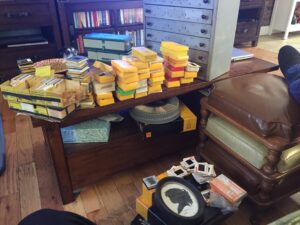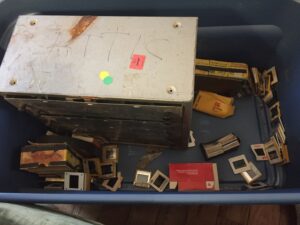Search and rescue
My parents and I recently went on a salvage mission. My family lived abroad for much of my childhood, and as a result, many of the family heirlooms had been scattered among various relatives. We’ve slowly been reacquiring the things we’d stored with relatives when we left (for what my parents imagined would be a brief 3-year sting abroad) and accruing new bits and pieces as relatives retire and divest themselves of ancestral clutter.
I use the word heirloom extremely loosely. The unfortunate truth is that much of this stuff is clutter at best. (I learned that lesson a few years ago when I helped clear out a storage unit – despite my relative’s earnest proclamations about heirlooms and family legacies, most of that stuff is still sitting in a storage unit of my own, damaged beyond repair by decades of neglect.) Without the memories, the stories, and the people, stuff is just stuff. It was a tough lesson to accept, and I still balk at it. As a historian of medieval Ireland, every fragmentary piece of evidence offers exciting possibilities for supplementing a badly damaged archival record. I love old things, and my desire to find and contextualize and share those old things is hampered only by my desire to maintain a relatively orderly home. So while there may come a time when I’m willing to devote hours and square footage to making broken family things whole again, that time is not now. The furniture will still be there in a decade, perhaps a little mustier, but probably in much the shape it’s in now.
For me, the most treasured heirlooms aren’t the things. They’re the records. They’re the letters, journals, and marginalia. They’re the photos and slides. They’re all the things that bring the people back into focus, that give us glimpses into the relationships and hopes and fears and desires that made meaning. So while I turned down the twin bed frames and the broken room screen, I leapt at the dusty plastic tote full of slides and the musty bag stuffed with papers.

Of course, now that I’ve got them, these collections present an enormous project. As my allergies can attest after a cursory exploration, that mildew smell isn’t just coming from the bag. Many of these slides have got visible mold (both on the housing and on the emulsion), and even the ones that are in relatively good shape are covered in decades worth of grime. Let me be a lesson to all historians and genealogists whose eyes are bigger than their proverbial stomachs, because now that I’ve got these things, I’ve got a duty of care.
So what do you do with a mountain of moldy slides? Disclaimer: While I’ve worked in various archives settings, I’m not a professional archivist. There are years of training that goes into learning the science of conservation and preservation. I do, however, have some sense of where to look.

First things first, I’m going to clean these suckers up, one box at a time. While the image might look daunting (and trust me, I am daunted), I’ve done a little preliminary sorting to identify the collections with the least grime and the most significant moments. Blown air and a soft brush are the first step. I could use canned air, but I worry about the chemicals for long-term stability, so I’ll use a little silicone bulb blower instead. After the initial cleaning, I’ll do an initial scan. Unfortunately, some forms of mold damage are irreversible, but blowing the image up will show me any imperfections on a bigger scale and help me evaluate the damage to the image itself.
Whatever the damage, I do intend to digitize all of them. I’ll store them in a new Omeka S instance where I’ll create user accounts for family members so that they can add image descriptions and metadata.
Eventually, I plan to open up some of the collections for teaching and research purposes. That’s mostly a post for another day, but it does overlap pretty substantially with the process of description and organization that I’m undertaking. Because even though the people are more visible in the slides than they are in the furniture, all of this work is for nothing without context.
So I’ve volunteered myself for a project of enormous magnitude. But one of my favorite things about family history is that it’s always done in community. In this case, I’ll draw upon my relatives for their knowledge and insights (and their labor). But even when it’s done in isolation, it offers a really tangible sense of connection with the past.